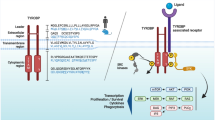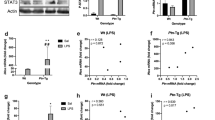Abstract
The receptor protein tyrosine phosphatase γ (Ptprg-RPTPγ) is a receptor protein widely expressed in many tissues, including the central nervous system (CNS). Several RPTPγ isoforms are expressed in the brain during development and in adulthood, but their distribution and role are unknown. In this study, we investigated the distribution of some RPTPγ isoforms in the adult brain using antibodies against the epitopes localized in the C- and in the N-terminal domains of the full length isoform of RPTPγ. We found a predominant and widespread neuronal positivity throughout the neocortex, hippocampus, striatum and in many nuclei of the brainstem and cerebellum. At least 2 distinct isoforms that can co-exist in various compartments in the same cell are detectable in different neuron types. Immunopositivity for epitopes located in both the N- and C-terminus domains were found in the neuropil of cortical and hippocampal neurons, whereas the N-terminal domain positivity was found in the soma, often without colocalization with its C-terminal counterpart. Among glial cells, some protoplasmic and perivascular astrocytes and the cerebellar Bergmann glia, express RPTPγ. The astrocytic expression of RPTPγ and putative processing isoforms of 120 and 80 kDa increases during neuroinflammation, in particular 24 h after LPS treatment. Activated astrocytes were found to be strongly positive for RPTPγ also in a mice model of Alzheimer’s disease. Our results confirm previous findings and enrich the current knowledge of RPTPγ distribution in the CNS, highlighting a role of RPTPγ during neuroinflammation processes.






Similar content being viewed by others
References
Barnea G, Silvennoinen O, Shaanan B, Honegger AM, Canoll PD, D’Eustachio P, Morse B, Levy JB, Laforgia S, Huebner K et al (1993) Identification of a carbonic anhydrase-like domain in the extracellular region of RPTP gamma defines a new subfamily of receptor tyrosine phosphatases. Mol Cell Biol 13(3):1497–1506
Barr AJ, Ugochukwu E, Lee WH, King ON, Filippakopoulos P, Alfano I et al (2009). Large-scale structural analysis of the classical human protein tyrosine phosphatome [Research Support, Non-U.S. Gov’t]. Cell 136(2):352–363. doi:10.1016/j.cell.2008.11.038
Bouyain S, Watkins DJ (2010) The protein tyrosine phosphatases PTPRZ and PTPRG bind to distinct members of the contactin family of neural recognition molecules. Proc Natl Acad Sci USA 107(6):2443–2448. doi:10.1073/pnas.0911235107
Candelario-Jalil E, Yang Y, Rosenberg GA (2009) Diverse roles of matrix metalloproteinases and tissue inhibitors of metalloproteinases in neuroinflammation and cerebral ischemia. Neuroscience 158(3):983–994. doi:10.1016/j.neuroscience.2008.06.025
Canoll PD, Petanceska S, Schlessinger J, Musacchio JM (1996) Three forms of RPTP-beta are differentially expressed during gliogenesis in the developing rat brain and during glial cell differentiation in culture [Research Support, U.S. Gov’t, P.H.S.]. J Neurosci Res 44(3):199–215. doi:10.1002/(SICI)1097-4547(19960501)44:3<199::AID-JNR1>3.0.CO;2-B
Cottrell CE, Bir N, Varga E, Alvarez CE, Bouyain S, Zernzach R et al (2011) Contactin 4 as an autism susceptibility locus [Case Reports Research Support, N.I.H., Extramural Research Support, U.S. Gov’t, Non-P.H.S.]. Autism Res 4(3):189–199. doi:10.1002/aur.184
Crocker SJ, Milner R, Pham-Mitchell N, Campbell IL (2006) Cell and agonist-specific regulation of genes for matrix metalloproteinases and their tissue inhibitors by primary glial cells. J Neurochem 98 (3):812–823. doi:10.1111/j.1471-4159.2006.03927.x
Dabrowski A, Umemori H (2011) Orchestrating the synaptic network by tyrosine phosphorylation signalling. J Biochem 149(6):641–653. doi:10.1093/jb/mvr047
Della Peruta M, Martinelli G, Moratti E, Pintani D, Vezzalini M, Mafficini A, Grafone T, Iacobucci I, Soverini S, Murineddu M, Vinante F, Tecchio C, Piras G, Gabbas A, Monne M, Sorio C (2010) Protein tyrosine phosphatase receptor type gamma is a functional tumor suppressor gene specifically downregulated in chronic myeloid leukemia. Cancer Res 70(21):8896–8906. doi:10.1158/0008-5472.CAN-10-0258
Faissner A, Heck N, Dobbertin A, Garwood J (2006) DSD-1-Proteoglycan/Phosphacan and receptor protein tyrosine phosphatase-beta isoforms during development and regeneration of neural tissues. Adv Exp Med Biol 557:25–53. doi:10.1007/0-387-30128-3_3
Gottschall PE, Deb S (1996) Regulation of matrix metalloproteinase expressions in astrocytes, microglia and neurons. Neuroimmunomodulation 3(2–3):69–75
Gottschall PE, Yu X (1995) Cytokines regulate gelatinase A and B (matrix metalloproteinase 2 and 9) activity in cultured rat astrocytes. J Neurochem 64(4):1513–1520
Hamshere ML, Green EK, Jones IR, Jones L, Moskvina V, Kirov G et al (2009) Genetic utility of broadly defined bipolar schizoaffective disorder as a diagnostic concept [Comparative Study Research Support, Non-U.S. Gov’t]. Br J Psychiatry 195(1):23–29. doi:10.1192/bjp.bp.108.061424
Harris JL, Reeves TM, Phillips LL (2011) Phosphacan and receptor protein tyrosine phosphatase beta expression mediates deafferentation-induced synaptogenesis [Research Support, N.I.H., Extramural]. Hippocampus 21(1):81–92. doi:10.1002/hipo.20725
Hashemi H, Hurley M, Gibson A, Panova V, Tchetchelnitski V, Barr A, Stoker AW (2011) Receptor tyrosine phosphatase PTPgamma is a regulator of spinal cord neurogenesis. Mol Cell Neurosci 46(2):469–482. doi:10.1016/j.mcn.2010.11.012
Hayashi N, Oohira A, Miyata S (2005) Synaptic localization of receptor-type protein tyrosine phosphatase zeta/beta in the cerebral and hippocampal neurons of adult rats. Brain Res 1050(1–2):163–169. doi:10.1016/j.brainres.2005.05.047
Hendriks WJ, Elson A, Harroch S, Pulido R, Stoker A, den Hertog J (2013) Protein tyrosine phosphatases in health and disease. FEBS J 280(2):708–730. doi:10.1111/febs.12000
Johnson KG, Van Vactor D (2003) Receptor protein tyrosine phosphatases in nervous system development. Physiol Rev 83(1):1–24. doi:10.1152/physrev.00016.2002
Kawachi H, Tamura H, Watakabe I, Shintani T, Maeda N, Noda M (1999) Protein tyrosine phosphatase zeta/RPTPbeta interacts with PSD-95/SAP90 family [Research Support, Non-U.S. Gov’t]. Brain Res Mol Brain Res 72(1):47–54
Kwon MS, Seo YJ, Choi SM, Won MH, Lee JK, Park SH, Jung JS, Sim YB, Suh HW (2010) The time-dependent effect of lipopolysaccharide on kainic acid-induced neuronal death in hippocampal CA3 region: possible involvement of cytokines via glucocorticoid. Neuroscience 165(4):1333–1344. doi:10.1016/j.neuroscience.2009.11.060
Lamprianou S, Harroch S (2006) Receptor protein tyrosine phosphatase from stem cells to mature glial cells of the central nervous system. J Mol Neurosci 29(3):241–255. doi:10.1385/JMN:29:3:241
Lamprianou S, Vacaresse N, Suzuki Y, Meziane H, Buxbaum JD, Schlessinger J, Harroch S (2006) Receptor protein tyrosine phosphatase gamma is a marker for pyramidal cells and sensory neurons in the nervous system and is not necessary for normal development. Mol Cell Biol 26(13):5106–5119. doi:10.1128/MCB.00101-06
Lamprianou S, Chatzopoulou E, Thomas JL, Bouyain S, Harroch S (2011) A complex between contactin-1 and the protein tyrosine phosphatase PTPRZ controls the development of oligodendrocyte precursor cells. Proc Natl Acad Sci USA 108(42):17498–17503. doi:10.1073/pnas.1108774108
Lee WJ, Shin CY, Yoo BK, Ryu JR, Choi EY, Cheong JH, Ryu JH, Ko KH (2003) Induction of matrix metalloproteinase-9 (MMP-9) in lipopolysaccharide-stimulated primary astrocytes is mediated by extracellular signal-regulated protein kinase 1/2 (Erk1/2). Glia 41(1):15–24. doi:10.1002/glia.10131
Mafficini A, Vezzalini M, Zamai L, Galeotti L, Bergamini G, Della Peruta M, Melotti P, Sorio C (2007) Protein tyrosine phosphatase gamma (PTPgamma) is a novel leukocyte marker highly expressed by CD34 precursors. Biomark Insights 2:218–225
Nishiwaki T, Maeda N, Noda M (1998) Characterization and developmental regulation of proteoglycan-type protein tyrosine phosphatase zeta/RPTPbeta isoforms. J Biochem 123(3):458–467
Oakley H, Cole SL, Logan S, Maus E, Shao P, Craft J, Guillozet-Bongaarts A, Ohno M, Disterhoft J, Van Eldik L, Berry R, Vassar R (2006) Intraneuronal beta-amyloid aggregates, neurodegeneration, and neuron loss in transgenic mice with five familial Alzheimer’s disease mutations: potential factors in amyloid plaque formation. J Neurosci 26(40):10129–10140. doi:10.1523/JNEUROSCI.1202-06.2006
Reinhard J, Horvat-Brocker A, Illes S, Zaremba A, Knyazev P, Ullrich A, Faissner A (2009) Protein tyrosine phosphatases expression during development of mouse superior colliculus. Exp Brain Res 199(3–4):279–297. doi:10.1007/s00221-009-1963-6
Romero-Calvo I, Ocon B, Martinez-Moya P, Suarez MD, Zarzuelo A, Martinez-Augustin O, de Medina FS (2010) Reversible Ponceau staining as a loading control alternative to actin in Western blots. Anal Biochem 401(2):318–320. doi:10.1016/j.ab.2010.02.036
Sakurai T, Friedlander DR, Grumet M (1996) Expression of polypeptide variants of receptor-type protein tyrosine phosphatase beta: the secreted form, phosphacan, increases dramatically during embryonic development and modulates glial cell behavior in vitro [Research Support, Non-U.S. Gov’t Research Support, U.S. Gov’t, P.H.S.]. J Neurosci Res43(6):694–706. doi:10.1002/(SICI)1097-4547(19960315)43:6<694::AID-JNR6>3.0.CO;2-9
Sandvig A, Berry M, Barrett LB, Butt A, Logan A (2004) Myelin-, reactive glia-, and scar-derived CNS axon growth inhibitors: expression, receptor signaling, and correlation with axon regeneration [Review]. Glia 46(3):225–251. doi:10.1002/glia.10315
Schumann G, Fiebich BL, Menzel D, Hull M, Butcher R, Nielsen P, Bauer J (1998) Cytokine-induced transcription of protein-tyrosine-phosphatases in human astrocytoma cells. Brain Res Mol Brain Res 62(1):56–64
Shintani T, Maeda N, Nishiwaki T, Noda M (1997) Characterization of rat receptor-like protein tyrosine phosphatase gamma isoforms. Biochem Biophys Res Commun 230(2):419–425. doi:10.1006/bbrc.1996.5973
Shintani T, Watanabe E, Maeda N, Noda M (1998) Neurons as well as astrocytes express proteoglycan-type protein tyrosine phosphatase zeta/RPTPbeta: analysis of mice in which the PTPzeta/RPTPbeta gene was replaced with the LacZ gene. Neurosci Lett 247(2–3):135–138
Shintani T, Maeda N, Noda M (2001) Receptor-like protein tyrosine phosphatase gamma (RPTPgamma), but not PTPzeta/RPTPbeta, inhibits nerve-growth-factor-induced neurite outgrowth in PC12D cells. Dev Neurosci 23(1):55–69
Sorio C, Mendrola J, Lou Z, LaForgia S, Croce CM, Huebner K (1995) Characterization of the receptor protein tyrosine phosphatase gene product PTP gamma: binding and activation by triphosphorylated nucleosides. Cancer Res 55(21):4855–4864
Tanaka M, Maeda N, Noda M, Marunouchi T (2003) A chondroitin sulfate proteoglycan PTPzeta/RPTPbeta regulates the morphogenesis of Purkinje cell dendrites in the developing cerebellum. J Neurosci 23(7):2804–2814
Tonks NK (2006) Protein tyrosine phosphatases: from genes, to function, to disease. Nat Rev Mol Cell Biol 7(11):833–846. doi:10.1038/nrm2039
Tremblay ML (2009) The PTP family photo album (Comment). Cell 136(2):213–214. doi:10.1016/j.cell.2009.01.006
Vezzalini M, Mombello A, Menestrina F, Mafficini A, Della Peruta M, van Niekerk C, Barbareschi M, Scarpa A, Sorio C (2007) Expression of transmembrane protein tyrosine phosphatase gamma (PTPgamma) in normal and neoplastic human tissues. Histopathology 50(5):615–628. doi:10.1111/j.1365-2559.2007.02661.x
Zhang W, Savelieva KV, Tran D, Pogorelov VM, Cullinan EB, Backer KB, Platt KA, Hu S, Rajan I, Xu N, Lanthorn TH (2012) Characterization of PTPRG in knockdown and phosphatase-inactive mutant mice and substrate trapping analysis of PTPRG in mammalian cells. PLoS ONE 7(9):e45500. doi:10.1371/journal.pone.0045500
Acknowledgments
This work was supported by University of Verona and Fondazione Cariverona-project Verona Nanomedicine Initiative. Development and characterization of antibodies were supported by AIRC IG 4667 and Consorzio per gli Studi Universitari, Verona.
Conflict of interest
The authors declare no competing financial interests.
Author information
Authors and Affiliations
Corresponding authors
Electronic supplementary material
Below is the link to the electronic supplementary material.
As an additional test for antibody specificity we stained some slides from one heterozygous and one RPTPγ KO mouse using the two antibodies against the N- (ch-RPTPγ, green) and the C-terminus (goat-RPTPγ, red) epitopes of the phosphatase. Cerebral cortex (A–F and J–O) and hippocampus (G–I and P–R) showed a strong decrease of RPTPγ signal in the KO (J–R) in comparison to the heterozygous (A–I). A residual staining was still present in some regions, in particular in the granular layer of the hippocampus, a region known to be prone to aspecific staining. Scale bars 50 μm.
Rights and permissions
About this article
Cite this article
Lorenzetto, E., Moratti, E., Vezzalini, M. et al. Distribution of different isoforms of receptor protein tyrosine phosphatase γ (Ptprg-RPTP γ) in adult mouse brain: upregulation during neuroinflammation. Brain Struct Funct 219, 875–890 (2014). https://doi.org/10.1007/s00429-013-0541-7
Received:
Accepted:
Published:
Issue Date:
DOI: https://doi.org/10.1007/s00429-013-0541-7




